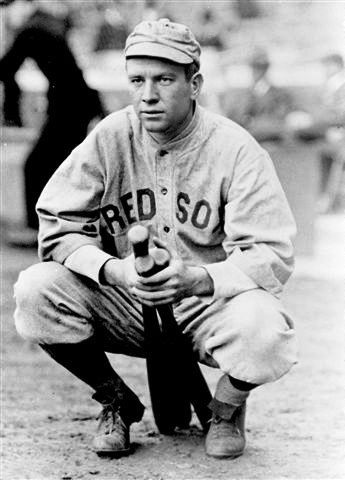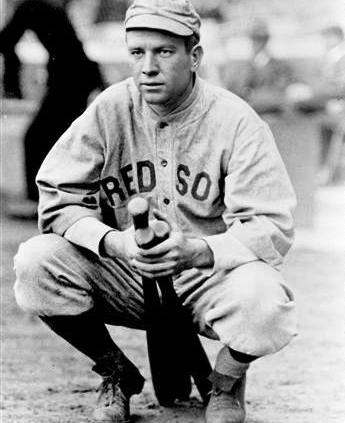April 22, 1914: Red Sox, Athletics tie for second day in a row
 At the start of play on April 22, 1914, eight days into the season, the Boston Red Sox won-lost record stood at 2-4-1. Connie Mack’s reigning World Series champion Philadelphia Athletics were 2-3-1. Bill Carrigan had become Red Sox manager a little more than halfway through the 1913 season, adding the duties to his role as a catcher for Boston. The Red Sox had finished in fourth place in the American League, 15½ games behind Philadelphia.
At the start of play on April 22, 1914, eight days into the season, the Boston Red Sox won-lost record stood at 2-4-1. Connie Mack’s reigning World Series champion Philadelphia Athletics were 2-3-1. Bill Carrigan had become Red Sox manager a little more than halfway through the 1913 season, adding the duties to his role as a catcher for Boston. The Red Sox had finished in fourth place in the American League, 15½ games behind Philadelphia.
The Athletics had swept a Patriots Day doubleheader at Fenway Park on Monday, April 20, scoring six runs in the top of the 10th in the first game and getting a four-hit shutout from 20-year-old lefty Herb Pennock in the second.
On April 21 two more young pitchers, Boston’s Dutch Leonard and Philadelphia’s Bob Shawkey, both went 13 innings, each allowing two walks and just one run. Leonard allowed seven hits and Shawkey allowed six.1 The Red Sox scored in the bottom of the third and the Athletics scored in the top of the sixth. The game ended after 13, a 1-1 tie, called on account of darkness.2
The Wednesday afternoon series finale was scheduled for a 2:00 P.M. start, rather than the usual 3:30, because both teams had to catch a 5:00 P.M. train – Philadelphia to head home and the Red Sox to continue to Washington to face the Senators.3 In both cities, the April 23 game was the home opener, and thus an exception was made to the AL edict that no game should be called simply to catch a train.4
Responsible for making sure everything ran on time at Fenway Park were two future Hall of Famers, both former players: home-plate umpire Bill Dinneen and base umpire Tommy Connolly.
Hugh Bedient, who had won 20 games for Boston’s 1912 World Series champions, started for the Red Sox, and he was touched for one run in the top of the first. With one out, left fielder Tom Daley singled and second baseman Eddie Collins drew a base on balls. After a second out, first baseman Stuffy McInnis singled to left field, driving in Daley. He might have driven in Collins, too, but for Duffy Lewis’s inning-ending throw to Hick Cady at home plate.
Byron Houck pitched for Mack’s Athletics. The Red Sox got runners on second and third with nobody out in the first, but Houck escaped without giving up a run. Boston tied the score in the bottom of the third, Bedient kicking things off with a single. Right fielder Harry Hooper sacrificed, putting Bedient in scoring position, and he did indeed score on a “stinging single by Tris Speaker.”5
The game was tied 1-1 through three innings, but the apparent pitchers’ duel soon turned into a slugfest. In the fourth inning, the Red Sox scored four runs. Philadelphia’s McInnis misplayed a ball hit by third baseman Larry Gardner, who reached second on the error. After one out, shortstop Everett Scott doubled down the left-field line, driving in Gardner. Scott slid into second base, just barely safe.
After a second out, Bedient walked and Hooper singled, driving in Scott. Hack Engle walked, too, loading the bases for Speaker, who singled and drove in Bedient and Hooper. The inning ended on a failed double steal, with Engle thrown out at the plate.
The Athletics responded right away, scoring four runs of their own. R.E. McMillin, writing for the Boston Journal, suggested that Bedient had “evidently been spending too much time out on the [base] paths.”6 With one out, Bedient walked shortstop Jack Barry. Catcher Wally Schang tripled. After a second out, right fielder Eddie Murphy singled, scoring Schang.
Daley then tripled to center and Collins doubled to right field. The game was again tied, 5-5.
Carrigan called on Fritz Coumbe to relieve Bedient. For Coumbe, it was his major-league debut. He got Home Run Baker to ground out for the third out.
Philadelphia’s Weldon Wyckoff relieved Houck and kept the Red Sox scoreless from the fifth through the seventh. In the meantime, the Athletics put another four runs on the board in their half of the seventh.
After first baseman Engle muffed one and Coumbe walked the next two, McInnis singled and drove in Wyckoff. Rube Foster relieved Coumbe and was greeted by singles by center fielder Amos Strunk and Barry, two RBIs for Strunk.
The Athletics had turned the 5-1 deficit into a 9-5 lead. The clock out in center field kept counting down.
The lead held until the Red Sox rallied in the bottom of the eighth. With one out, Scott drew a walk. Cady hit a high fly to Murphy in right, who lost it in the late-afternoon sun for his second error of the game.7 Pinch-hitter Olaf Henriksen struck out, but Hooper doubled, driving in one. Engle walked, loading the bases.
With Speaker due up, Mack summoned 38-year-old lefty Eddie Plank to relieve Wyckoff. On a 3-and-2 count, and the runners off with the pitch as Plank took a long windup, Speaker dropped a Texas Leaguer into left field. Daley, playing deep, slipped a bit, the ball fell in just in front of him, and all three runners scored, tying the game, 9-9.
Lewis flied out, ending the inning, and the game was promptly called by Dinneen, at 4:20 P.M.8 There is no indication that either team missed the Federal Express train.
Speaker had five RBIs in the game and Hooper had three. McInnis and Strunk led the Athletics with two apiece.
The Athletics had committed three errors to Boston’s two. Only one of Boston’s nine runs was charged as an earned run to an Athletics pitcher. Seven of Philadelphia’s runs were earned runs. Strikeouts were even, three per team. The Red Sox walked five, the Athletics four. The Red Sox left seven on base and the Athletics left six.
The Philadelphia Inquirer concluded, “It was about as bush league an affair for both teams as could be imagined, and a tie score was about all that was due either of the contestants.”9 The Boston Globe wasn’t as unkind, but did start its coverage saying, “Another tie resulted in the game yesterday between the Red Sox and the World’s Champion Philadelphia Athletics. It was sort of a freak game in many ways.”10
Wallace Goldsmith’s sports page cartoon in the Boston Globe not only depicted how Speaker’s three-run hit had dropped in, but featured a fan in the stands proclaiming, “Aw shucks! Here I been doin’ a watchful waitin’ fer two days to see a finish and it ain’t not yet eventuated.”11
The tie games were made up by scheduling doubleheaders on June 2 and 3. The Red Sox lost three of those four games.
The Athletics easily won the pennant, 8½ games ahead of the second-place Red Sox. (Both clubs tied six games in 1914, which resulted in Boston playing 159 games to complete its 154-game schedule, and Philadelphia playing 158 games.) But Philadelphia lost the World Series, swept by the “Miracle Braves” in four games, with the Boston Braves’ home games played at Fenway Park.12
Acknowledgments
This article was fact-checked by Ray Danner and copy-edited by Len Levin.
Photo credit: Tris Speaker, National Baseball Hall of Fame Library.
Sources
In addition to the sources cited in the Notes, the author consulted Baseball-Reference.com and Retrosheet.org.
https://www.baseball-reference.com/boxes/BOS/BOS191404220.shtml
https://www.retrosheet.org/boxesetc/1914/B04220BOS1914.htm
Notes
1 Leonard’s 0.96 earned-run average in 1914 remains the best ever achieved in American League history. Shawkey’s contract was sold to the New York Highlanders in 1915 and he won 168 games for them.
2 Tie games were more common at the time and Tim Murnane, writing in the Boston Globe, said that the small crowd was “perfectly satisfied” that umpire Tommy Connolly had called the game. T.H. Murnane, “Macks and Sox Tie in 13 Innings,” Boston Globe, April 22, 1914: 9. It was cold and fewer than 2,500 were present. Boston’s run scored on back-to-back two-out singles by right fielder Harry Hooper and first baseman Hack Engle, followed by a grounder that center fielder Tris Speaker hit which was misplayed by second baseman Eddie Collins. Philadelphia’s run was set up by Shawkey singling down the right-field line, a bunt by right fielder Eddie Murphy, and an error by Leonard on a throw to second base for an attempted force play. Left fielder Tom Daley then bunted to move the two runners ahead. Third baseman Larry Gardner threw the ball to second, but Steve Yerkes dropped it. The bases were loaded with nobody out. Collins hit into a 6-4-3 double play, Shawkey scoring the tying run. Leonard struck out Home Run Baker on three pitches. Six times in the game, the Athletics’ leadoff batter got on base; Boston never did. Only twice after the first inning did the Red Sox leave a man in scoring position; Philadelphia did so five times.
3 Expecting to play a baseball game, get dressed, make it to the train station, and board in three hours seemed am ambitious bit of scheduling.
4 “Sox and Athletics Play Another Tie,” Boston Herald, April 23, 1914: 8.
5 R.E. McMillin, “Give and Take and Even Score for the Red Sox,” Boston Journal, April 23, 1914: 8.
6 McMillin.
7 The Herald was unforgiving, writing, “Any schoolboy would have been expected to make the catch.” “Sox and Athletics Play Another Tie.”
8 “Texas Leaguer Was Costly to Macks,” Philadelphia Inquirer, April 23, 1914: 12.
9 “Texas Leaguer Was Costly to Macks.”
10 James C. O’Leary, “Red Sox and Champs Again Tie,” Boston Globe, April 23, 1914: 7.
11 Wallace Goldsmith, “Tangle-Tied,” Boston Globe, April 23, 1914: 7.
12 For the story of the 1914 Boston Braves and that year’s World Series, see The Miracle Braves of 1914: Boston’s Original Worst-to-First World Series Champions, ed. Bill Nowlin (Phoenix: SABR, 2014).
Additional Stats
Boston Red Sox 9
Philadelphia Athletics 9
8 innings
Fenway Park
Boston, MA
Box Score + PBP:
Corrections? Additions?
If you can help us improve this game story, contact us.


